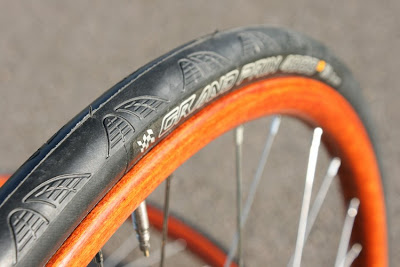In part 1 of my Renovo R1 wooden bike project I told you something about the frame of the bike. In part 2 I will give you some insight in the wheels and the groupset that I will be using.
To complement the wooden frame I decided to use wooden rims for the wheels. Wooden rims are mostly a thing of the past, but two companies in Italy still build them: Cerchi Ghisallo and CB Italia. Both companies sell clincher and tubular rims. I choose to go with Cerchi Ghisallo rims because they supply a clincher rim with a carbon fibre inlay. Without the inlay a tire on a wooden rim can only be inflated up to 4-5 bars, so you would have to run 28c or bigger tires. With the inlay you can inflate the tires to more conventional road bike pressures (8 bars), so you can run 23c and 25c tires. The rims are built by laminating strips of Slovenian beech wood together and the end result is simply amazing!
One the cool things about the rims is that they have a hookless tire bead. Lew Racing did a similar thing on their Lew Racing VC-1 carbon clincher rim. I believe Lew calles/called it BSC technology (« Bead Seat Clincher« ). The tire stays onto the rim by the pressure of the tire on the opposite side. For this reason you can only use a high quality tire, whereas deviations in the tire would cause bulges on the surface of the tire.
The rims were built onto Shimano Dura Ace 7700 hubs with silver DT Swiss Competiton spokes. DA 7700 hubs are very highly rated hubs, because they are durable and the bearings used are extremely smooth. However, I did not use standard DA 7700 hubs. I used Shimano DA 7700 25th anniversary hubs. These are part of a complete DA 25th anniversary groupset that I was able to buy brand new. The group dates back to 1998 and was a special edition of the DA 7700 series. It features 25th anniversary logo's, a high polished finish and some extra titanium bolts and pieces.
One of the things that make wooden rims so special is their ability to flex. To accommodate this flexibility, the wheels were built with about half the spoke tension that is normally used on aluminium or carbon wheels. The end result is a wheel that will ride very smooth on bad roads. Wood does not absorb heat so you can't use regular brake pads, because they would melt. That is why I plan to use either cork pads or Swiss Stop yellow pads. I mounted Continental GP4000 S 25c tires, simply because I really like these tires. They are very hard to puncture yet still deliver a great riding experience.
Here are a couple of picturs of the rims, the hubs and the end result, including pictures of the building of the wheels. In part 3 I will tell you more on the front fork and stem assembly that will come onto the bike.

























No comments:
Post a Comment